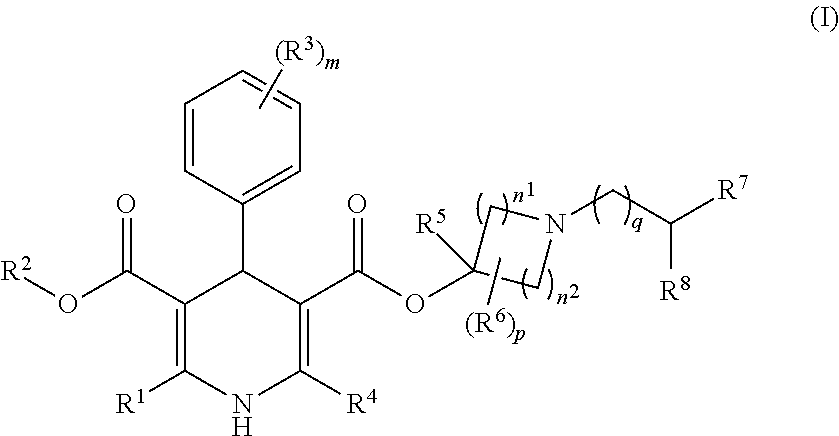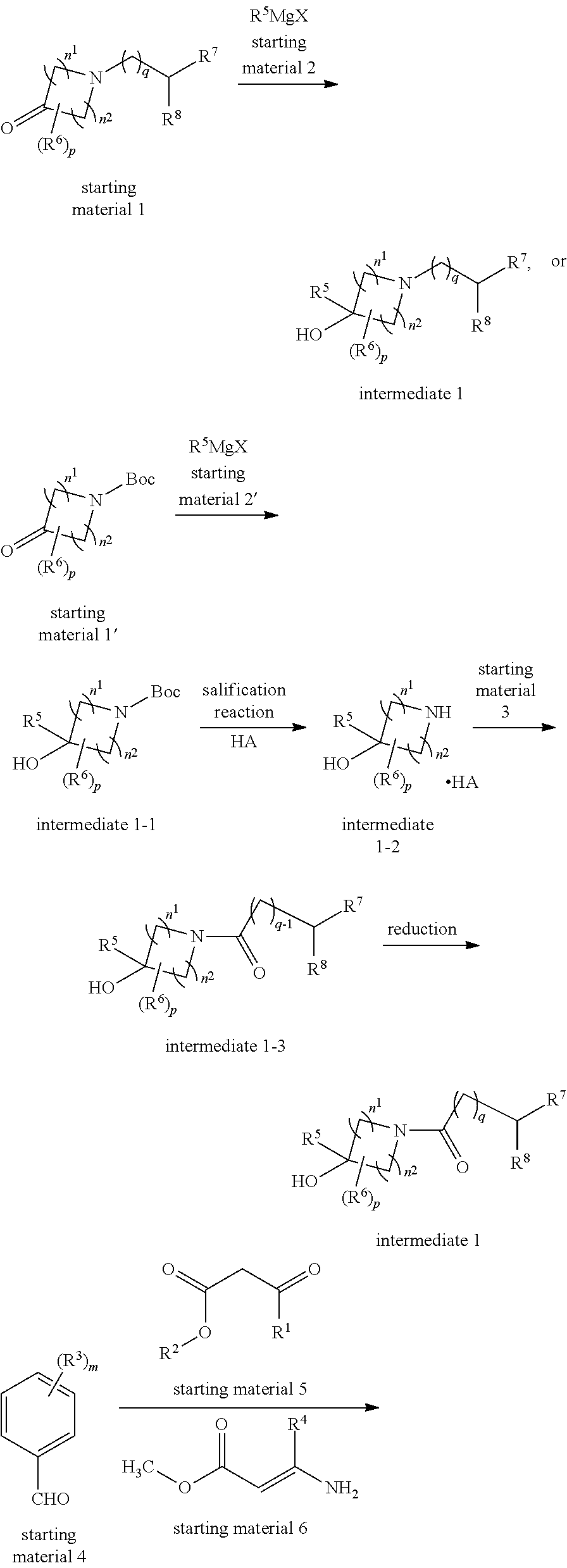1,4-dihydropyridine-3,5-dicarboxylate Derivatives And Preparation And Use Thereof
a technology of dihydropyridine and derivatives, applied in the field of pharmaceutical technology, can solve the problems of increasing the risk of heart complication, remarkable negative effect on the heart, and large fluctuation of blood pressure, and achieve the effect of maintaining the hypotensive effect and observing the hypotensive
- Summary
- Abstract
- Description
- Claims
- Application Information
AI Technical Summary
Benefits of technology
Problems solved by technology
Method used
Image
Examples
example 1
Preparation of 3-(1-benzyl-3-methylpyrrolidin-3-yl) 5-methyl 2,6-dimethyl-4-(3-nitrophenyl)-1,4-dihydropyridine-3,5-dicarboxylate (Compound 1) and its hydrochloride
[0066]
(1) Preparation of 1-benzyl-3-methylpyrrolidin-3-ol
[0067]
[0068]1-benzylpyrrolidone (1.1 g, 6.3 mmol) was dissolved in 4 mL THF under stirring at −20° C. The resulting solution was dropwisely added to a solution of methyl magnesium bromide (13.2 mL, 12.2 mmol) in THF. The stirring was continued for 3 hours. After the completion of reaction, the reaction solution was dropwisely added to an ice water. The resulting mixture was washed with a saturated aqueous NaCl solution, dried over Na2SO4, and purified by column chromatography (silica gel column, eluted with petroleum ether: ethyl acetate=20:1 (volumetric ratio)) to produce the product of 1-benzyl-3-methylpyrrolidinyl-3-ol (0.7 g) in a yield of 58.1%.
(2) Preparation of dimethyl 2,6-dimethyl-4-(3-nitrophenyl)-1,4-dihydropyridine-3,5-dicarboxylate
[0069]
[0070]5 g meta-n...
example 2
Preparation of 3-[1-(3,3-diphenylpropyl)-3-methylpyrrolidin-3-yl]5-methyl 2,6-dimethyl-4-(3-nitrophenyl)-1,4-dihydropyridine-3,5-dicarboxylate (Compound 2) and its hydrochloride
[0080]
(1) Preparation of 3-methylpyrrolidin-3-ol hydrochloride
[0081]
[0082]A solution of tert-butyl 3-carbonylpyrrolidine-1-carboxylate (11.17 g, 0.06 mol) in THF (45 mL) was slowly added to a solution of MeMgl (21.41 g, 0.129 mol) in diethyl ether. The reaction was conducted at −20° C. under stirring for 3 hours. A small amount of water was added to the reaction solution. The resulting reaction solution was filtered by suction. The filtrate was extracted with dichloromethane. The organic layer was dried over anhydrous sodium sulfate and filtered. The filtrate was concentrated to produce a crude product of tert-butyl 3-hydroxy-3-methyl-pyrrolidine-1-carboxylate. The above crude product was dissolved in 20 mL 1,4-dioxane. To the resulting solution was introduced an HCl gas. The resulting mixute was stirred over...
example 3
Preparation of 3-(1-benzyl-3-methylpyrrolidin-3-yl) 5-ethyl 2,6-dimethyl-4-(3-nitrophenyl)-1,4-dihydropyridine-3,5-dicarboxylate (Compound 3)
[0091]
[0092]The steps in Example 1 were repeated, except that the reactant in step (2) methyl acetoacetate was replaced with ethyl acetoacetate to obtain Compound 3.
[0093]MS (M+H): 520.3.
PUM
| Property | Measurement | Unit |
|---|---|---|
| Stereoisomer | aaaaa | aaaaa |
Abstract
Description
Claims
Application Information
 Login to View More
Login to View More - R&D
- Intellectual Property
- Life Sciences
- Materials
- Tech Scout
- Unparalleled Data Quality
- Higher Quality Content
- 60% Fewer Hallucinations
Browse by: Latest US Patents, China's latest patents, Technical Efficacy Thesaurus, Application Domain, Technology Topic, Popular Technical Reports.
© 2025 PatSnap. All rights reserved.Legal|Privacy policy|Modern Slavery Act Transparency Statement|Sitemap|About US| Contact US: help@patsnap.com



